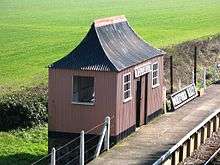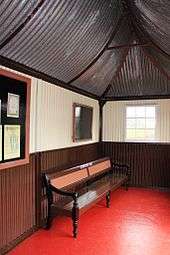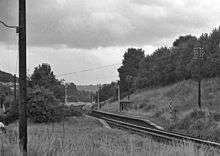GWR pagoda platform shelter
The archetypal Pagoda Platform Shelter was a distinctively-shaped corrugated iron structure used by passengers waiting at railway stations in Wales and southern England.


Origins
In Britain Pagoda shelters are associated with the Great Western Railway (GWR) who introduced them in 1907 and erected a patchwork of them across their network. They were manufactured by an outside supplier and delivered in kit form.[1] They could therefore be assembled offsite, delivered on standard well wagons and craned into position,[2][3] or assembled onsite, according to circumstances.
The GWR opened its first "Haltes" on 12 October 1903, anglicising the name to "Halt" in 1905. They were prime candidates for Pagoda shelters, but the market was crowded: finance, tradition, knowledge, skills and materials to hand meant that some lines had pagodas aplenty, some one or two and others none at all. The Bala to Ffestiniog Line in upland Wales, for example, had six halts erected at remote, virgin sites between the World Wars, Teigl Halt and Llafar Halt had pagoda shelters, but Trawsfynydd Lake Halt, Bryn-Celynog Halt, Tyddyn Bridge Halt and Capel Celyn Halt had shelters with other designs.
Opening halts and standardising cheap to install and cheap to buy infrastructure in the face of competition firstly from trams, then buses and ultimately cars overlapped with other initiatives such as the railmotor.[4]
Spread
Pagoda shelters were generally associated with branch lines, but many were erected next to regional arteries and some were erected next to main lines; Challow being an example on what was and remains a high speed route out of Paddington.[5]
Specifications
Although they were renowned for their shape, their greatest virtues were their cost, simplicity and durability, coupled with the fact that the GWR "took them seriously". They were built to precise working drawings with materials to exact engineering specifications. The example installed at the remote Teigl Halt, for example, had a roof made of "No. 18 SWG Galvanised 3 inch Corrugated Sheeting [...] with a floor of specially prepared timber."[6][7][8][9]
Suitability
Many small halts used wooden platforms on a timber frame, rather than masonry or earth. The pagoda shelter could be used for these because of its light weight.[10][11]
Platform configurations
A pagoda shelter was typically provided for each platform, as, for example, at Truthall Halt.[12] As the halts where they were used were mostly on single-track lines, there was only one shelter, though Bilson Halt had only one platform with two pagoda shelters.[13] Stations such as Radipole and Ruislip Gardens with two platforms, had two, one on each platform,[14][15] as did Appleford.[16] Harlech[17][18][19][20] and Loudwater[21] had two platforms but a pagoda shelter opposite the masonry station building only. Perivale Halt had several on each platform.[22] Defiance Halt (later Defiance Platform) had one on each platform initially, but two more were added to the Up platform during the station's life.[23] Bala Junction had three platform faces with a pagoda shelter only on the most southerly.[24][25]
Variations
Most pagoda shelters were simple structures with one doorway leading into one room. At Kelmscott and Langford, however, the station building was a "Pagoda Building", with three doors and four windows facing the platform and rooms inside for different purposes.[26] Penhelig still has a pagoda shelter which used to incorporate a "lean-to" staff cabin at the Aberdyfi end.[27][28] The lean-to appears to have been incorporated into the overall building since it was de-staffed. The shelter differs from most pagodas in that it is either built of or clad with timber.[29]
Although the standard pagoda shelter measured 20 feet (6.1 m) by 8 feet (2.4 m),[30] they could be erected to different dimensions, occasionally at the same location, such as Dawlish Warren.[31]
Uses
The shelters were mainly used by passengers waiting for trains, but at least two - at Legacy[32] and Tetbury[33] - were "Pagoda lamp huts", whilst one at Witney was a shed.[34] Fairford[35][36] and Twyford each had a "Pagoda bike shed". Pagoda huts existed next to Weymouth Junction signalbox,[37] and in Hagley station goods yard,[38] neither was for passenger use. A Pagoda shelter was erected at right angles to the track next to the down platform at Festiniog, unsigned and painted black;[39][40] research continues into its purpose. It was still there in 1989, 28 years after the station closed and long after all other buildings had been demolished.[41][42][43]
Other railways' pagoda shelters
The GWR did not have a complete monopoly of pagoda shelters; Grogley Halt, Nanstallon Halt and Dunmere Halt[44] on the former LSWR branch near Bodmin in Cornwall had one each.[45] In the USA Pagoda shelters were adopted on a grand scale by at least one railroad.[46]
The present
By 2015
- a few, such as Denham Golf Club, survived in ordinary use
- some survived on preserved railways
- some have been erected as new builds on such lines[47][48]
- at least one has been rescued from a derelict site and installed on a preserved railway[49] and
- the shelter and other platform furniture at Llanerch-Ayron Halt have been preserved, but not the railway.
Most, however, have been demolished
- either to be replaced with a more modern structure, as at Machynlleth, or
- demolished along with the station, as at Llafar Halt, or
- obliterated along with the line and station, as at Mount Hawke and Goonhavern Halts.[50]
Gallery
.jpg)

- "Alvescot". The Fairford Branch.
- "Backney Halt". Landscape Origins of the Wye Valley. Archived from the original on 11 September 2011. Retrieved 4 October 2016.
- "Boxford". Disused Stations.
- "Bromley Halt". Rail Around Birmingham.
- "Brymbo (GWR)". Disused Stations.
- "Buckfastleigh". South Devon Railway.
- "Calne (free login needed to zoom)". Britain from above.
- "Cheltenham High Street Halt". Archive Images.
- "Chudleigh Knighton Halt". Disused Stations.
- "Cleobury Mortimer". Google Images.
- "Coryates Halt". Disused Stations.
- "Coryton". Urban75.
- "Cove Halt". Cornwall Railway Society.
- "Deeside Halt". Llangollen Railway.
- "Drybrook Halt". Forest of Dean Family History.
- "Drybrook Halt". SunGreen.
- "Dunmere Halt". Cornwall Railway Society.
- "East Garston". Disused Stations.
- "Goonbell Station". NRM. Archived from the original on 25 December 2016. Retrieved 24 December 2016.
- "Gornal Halt". Rail Around Birmingham.
- "Great Shefford". Disused Stations.
- "Grimes Hill & Wythall Platform". Warwickshire Railways.
- "Ham Green Halt". Bristol Railway Archives.
- "Kidderminster, ex-Allscott Sidings". Friends of Kidderminster Town.
- "Lechlade". The Fairford Branch.
- "Luxulyan". NRM. Archived from the original on 6 October 2016. Retrieved 4 October 2016.
- "Mount Hawke Halt". NRM. Archived from the original on 6 October 2016. Retrieved 4 October 2016.
- "Newbury West Fields Halt". Disused Stations.
- "Old Oak Lane Halt". David Heys Collection.
- "Pencarrow Bridge". RMweb.
- "Pentrecourt Platform". Pentrecourt Platform.
- "Rhiwbina Halt". Urban75.
- "Shaugh Bridge Paltform". Urban75.
- "Speen". Disused Stations.
- "Spring Road Halt". Rail Around Birmingham.
- "Stanley Bridge Halt". Disused Stations.
- "Stockcross & Bagnor". Disused Stations.
- "Towersey Halt". Towersey Village. Archived from the original on 5 October 2016. Retrieved 4 October 2016.
- "Trumper's Crossing Halt". Disused Stations.
- "Truthall Halt". NRM. Archived from the original on 6 October 2016. Retrieved 4 October 2016.
- "Welford Park". Disused Stations.
- "Willersey Halt". Willersey.
- "Wootton Wawen Platform". Warwickshire Railways.
References
- Reade 1983, Section: In praise of halts.
- "Installing Northwood Halt's pagoda shelter". SVR.
- "Northwood Halt's pagoda shelter". Bewdley Station.
- "Railmotors and halts with pagoda shelters". Bygone transport.
- Robertson 2004, p. 4.
- Southern 1995, pp. 77-9.
- Mitchell & Smith 2010, Photo 38.
- Coleford 2010b, p. 583.
- Green 1996, p. 38.
- "Pagoda shelter at Rodmarton Platform". Bygone Transport.
- Leigh 1984, pp. 70–71.
- Butt 1995, p. 235.
- "Pagoda shelters at Bilson Halt". Archive images.
- "Pagoda shelters at Radipole Halt". Disused Stations.
- Wells 2016, p. 378.
- Mitchell & Smith 2003, Photos 15 & 17.
- "Harlech's pagoda shelter". Britain from Above (free login needed to zoom).
- "Pagoda Shelter at Harlech". BBC.
- Mitchell & Smith 2009, Photos 34 and 37.
- Rear & Williams 1988, Photos 100, 102 & 103.
- Saunders 1962, p. 105.
- "Perivale Halt" (PDF). lurs.
- "Defiance Halt". Bruce Hunt.
- Mitchell & Smith 2010, Plate 2.
- Clemens 2003, 10 mins from start.
- "Pagoda building at Kelmscott and Langford station". The Fairford Branch.
- "Pagoda building and lean-to at Penhelig". RCTS.
- Rear & Williams 1988, Photos 15-17.
- "Pagoda building and lean-to at Penhelig". Geograph.
- Vaughan 1977.
- "Pagoda shelters at Dawlish Warren". Francis Frith.
- Christiansen 1976, p. 35.
- Karau 1977, p. 77.
- "Pagoda shed at Witney station". The Fairford Branch.
- Leigh 1995, p. 205.
- Karau 1977, p. 35.
- "Pagoda hut at Weymouth". Disused Stations.
- "Pagoda hut at Hagley". Disused Stations.
- Coleford 2010b, p. 582.
- Mitchell & Smith 2010, Photos 35-37.
- "Blaenau to Maentwrog Rd by DMU in 1989, Part 4". YouTube at 1min 44 sec.
- "Pagoda building on Festiniog station". Archive images.
- "Pagoda platform building at Festiniog station after closure". RM Web.
- McCormack & Jenkins 2016, p. 8.
- Hawkins 1999, pp. 209-212.
- "Pagoda depots in Delaware". My large scale.
- "Pagoda shelter at Glyndyfrdwy". Honda Wanderer.
- "Pagoda shelter at Lawley Village". Telford Steam Railway.
- "Pagoda shelter at Doniford Halt". Yahoo.
- Reade 1983, Section: Back to Nature.
Sources
- Butt, R. V. J. (1995). The Directory of Railway Stations: details every public and private passenger station, halt, platform and stopping place, past and present (1st ed.). Sparkford: Patrick Stephens Ltd. ISBN 978-1-85260-508-7. OCLC 60251199.
- Christiansen, Rex (1976). Forgotten Railways: North and Mid Wales. Newton Abbot: David and Charles. ISBN 978-0-7153-7059-9.CS1 maint: ref=harv (link)
- Clemens, Jim (2003) [1959]. North Wales Steam Lines (DVD). The Jim Clemens Collection No.6. Uffington, Shropshire: B&R Video Productions. Vol 79.CS1 maint: ref=harv (link)
- Coleford, I. C. (October 2010a). Smith, Martin (ed.). "By GWR to Blaenau Ffestiniog (Part One)". Railway Bylines. Radstock: Irwell Press Limited. 15 (11). ISSN 1360-2098.CS1 maint: ref=harv (link)
- Coleford, I. C. (November 2010b). Smith, Martin (ed.). "By GWR to Blaenau Ffestiniog (Part Two)". Railway Bylines. Radstock: Irwell Press Limited. 15 (12). ISSN 1360-2098.CS1 maint: ref=harv (link)
- Green, C.C. (1996) [1983]. North Wales Branch Line Album. Shepperton: Ian Allan Publishing. ISBN 978-0-7110-1252-3.CS1 maint: ref=harv (link)
- Hawkins, Mac (1999). LSWR West Country Lines: Then and Now. Rochester: Grange Books Ltd. ISBN 978-1-84013-322-6.CS1 maint: ref=harv (link)
- Karau, Paul (1977). Great Western Branch Line Termini: v. 1. Worthing: Littlehampton Book Services Ltd. ISBN 978-0-902888-89-0.CS1 maint: ref=harv (link)
- Leigh, Chris (1995). A Railway Modeller's Picture Library. Book Club Associates. ISBN 978-0-7110-2392-5. CN 3218.CS1 maint: ref=harv (link)
- Leigh, Chris (1984). GWR Country Stations:2. Shepperton: Ian Allan Publishing. ISBN 978-0-7110-1438-1.CS1 maint: ref=harv (link)
- McCormack, Kevin; Jenkins, Martin (2016). Britain's Declining Secondary Railways Through the 1960s. Barnsley: Pen and Sword. ISBN 978-1-47386-0-292.CS1 maint: ref=harv (link)
- Mitchell, Victor E.; Smith, Keith (2010). Bala to Llandudno: Featuring Blaenau Ffestiniog. Country Railway Routes. Midhurst: Middleton Press (MD). ISBN 978-1-906008-87-1.CS1 maint: ref=harv (link)
- Mitchell, Victor E.; Smith, Keith (2009). Barmouth to Pwllheli. Western Main Lines. Midhurst: Middleton Press. ISBN 978-1-906008-53-6.CS1 maint: ref=harv (link)
- Mitchell, Victor E.; Smith, Keith (2003). Didcot to Banbury. Western Main Lines. Midhurst: Middleton Press. ISBN 978-1-904474-02-9.CS1 maint: ref=harv (link)
- Reade, Lewis (1983). Branch Line Memories Vol 1. Redruth: Atlantic Transport & Historical Publishers. ISBN 978-0-906899-06-9.CS1 maint: ref=harv (link)
- Rear, W.G.; Williams, M.F. (1988). The Cambrian Coast Railway. Abergavenny: Foxline Publishing. ISBN 978-1-870119-03-0. Scenes from the Past: 4.CS1 maint: ref=harv (link)
- Robertson, Kevin (2004) [1999]. Odd Corners of the GWR: From the Days of Steam. Stroud: Sutton Publishing Ltd. ISBN 978-0-7509-3458-9.CS1 maint: ref=harv (link)
- Saunders, F.J. (February 1962). Cooke, B.W.C. (ed.). "Western Branch Trains". The Railway Magazine. London: Tothill Press Limited. 108 (730). ISSN 0033-8923.CS1 maint: ref=harv (link)
- Southern, D. W. (1995). Bala Junction to Blaenau Ffestiniog. Scenes from the Past, Railways of North Wales. Stockport: Foxline Publishing. ISBN 978-1-870119-34-4. No. 25.CS1 maint: ref=harv (link)
- Vaughan, Adrian (1977). A Pictorial Record of Great Western Architecture. OPC Railprint. ISBN 978-0-902888-22-7.CS1 maint: ref=harv (link)
- Wells, Jeffrey (June 2016). Blakemore, Michael (ed.). "The Opening of Railway Halts 1930-1935". Back Track. Easingwold: Pendragon Publishing. 30 (6).CS1 maint: ref=harv (link)
Further material
- Clarke, R. H. (Ed) (1986). An Historical Survey of Selected Great Western Stations: Vol. 2. Oxford: Oxford Publishing. ISBN 978-0-86093-015-0.CS1 maint: extra text: authors list (link) CS1 maint: ref=harv (link)
- Norris, John; Beale, Gerry; Lewis, John (1987). Edwardian Enterprise. Nottingham: Wild Swan Publications Ltd. ISBN 978-0-906867-39-6.CS1 maint: ref=harv (link)
External links
| Wikimedia Commons has media related to Great Western Railway pagoda platform shelters. |
- "Informed discussion of the topic". RMweb.
- "GWR Pagoda shelters". Museum of Thin Objects.